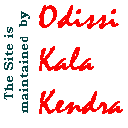|
|
|
 |
Odissi - the Sculpturesque Dance of India |
|||
|
The
Natya Shastra classifies dance into four regional types:
Avanti, Dakshinatya, Panchali and Odhra-Magadhi.
According to the same text, the Odhra-Magadhi type was
prevalent in Anga, Vanga, Kalinga, Vatsa, Odhra, Magadha,
Pundra and certain other easter regions of India. Among
these Kalinga and Odhra refer to the present state of
Orissa. Thus it can be concluded that a shastraic or
classical tradition of dance was prevalent in this part
of India even 2000 years ago (the date of composition of
the Natya Shastra. In the matter of technique, Odissi is a highly stylized dance. It is based on texts such as the Natya Shastra, Abhinaya Darpana, and Abhinaya Chandrika. Odissi has an exhaustive dance vocabulary. The tribhanga, or the thrice-bent, attitude of Hindu sculpture and iconography has been well exploited by Odissi. In fact, Odissi has the distinction of being the classical dance style most closely related to sculpture. Among the various aspects of Odissi are the belis, or principal body positions combined with movement. One such is the bhasa, in which the dancer bends the body alternately to the right and left and the hands move gracefully, rather like the actions of a swimmer. |
|||